DNA breaks are masked by multiple Rap1 binding in yeast: implications for telomere capping and telomerase regulation
- PMID: 17289918
- PMCID: PMC1785115
- DOI: 10.1101/gad.400907
DNA breaks are masked by multiple Rap1 binding in yeast: implications for telomere capping and telomerase regulation
Abstract
Eukaryotic cells distinguish their chromosome ends from accidental DNA double-strand breaks by packaging them in a protective structure referred to as the telomere "cap." Here we investigate the nature of the telomere cap by examining events at DNA breaks generated adjacent to either natural telomeric sequences (TG repeats) or arrays of Rap1-binding sites that vary in length. Although DNA breaks adjacent to either short or long telomeric sequences are efficiently converted into stable telomeres, they elicit very different initial responses. Short telomeric sequences (80 base pair [bp]) are avidly bound by Mre11, as well as the telomere capping protein Cdc13 and telomerase enzyme, consistent with their rapid telomerase-dependent elongation. Surprisingly, little or no Mre11 binding is detected at long telomere tracts (250 bp), and this is correlated with reduced Cdc13 and telomerase binding. Consistent with these observations, ends with long telomere tracts undergo strongly reduced exonucleolytic resection and display limited binding by both Rpa1 and Mec1, suggesting that they fail to elicit a checkpoint response. Rap1 binding is required for end concealment at long tracts, but Rif proteins, yKu, and Cdc13 are not. These results shed light on the nature of the telomere cap and mechanisms that regulate telomerase access at chromosome ends.
Figures
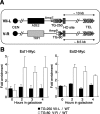
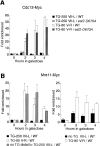

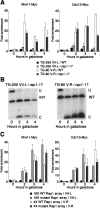

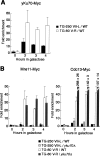
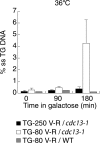
Similar articles
-
Cdc13 and telomerase bind through different mechanisms at the lagging- and leading-strand telomeres.Mol Cell. 2010 Jun 25;38(6):842-52. doi: 10.1016/j.molcel.2010.05.016. Mol Cell. 2010. PMID: 20620955
-
New function of CDC13 in positive telomere length regulation.Mol Cell Biol. 2001 Jul;21(13):4233-45. doi: 10.1128/MCB.21.13.4233-4245.2001. Mol Cell Biol. 2001. PMID: 11390652 Free PMC article.
-
Ten1p promotes the telomeric DNA-binding activity of Cdc13p: implication for its function in telomere length regulation.Cell Res. 2009 Jul;19(7):849-63. doi: 10.1038/cr.2009.67. Cell Res. 2009. PMID: 19532124
-
Hiding at the ends of yeast chromosomes: telomeres, nucleases and checkpoint pathways.J Cell Sci. 2003 Oct 15;116(Pt 20):4057-65. doi: 10.1242/jcs.00765. J Cell Sci. 2003. PMID: 12972499 Review.
-
Protection against chromosome degradation at the telomeres.Biochimie. 2008 Jan;90(1):41-59. doi: 10.1016/j.biochi.2007.07.008. Epub 2007 Jul 24. Biochimie. 2008. PMID: 17764802 Review.
Cited by
-
Tel1 and Rad51 are involved in the maintenance of telomeres with capping deficiency.Nucleic Acids Res. 2013 Jul;41(13):6490-500. doi: 10.1093/nar/gkt365. Epub 2013 May 15. Nucleic Acids Res. 2013. PMID: 23677619 Free PMC article.
-
Life on the edge: telomeres and persistent DNA breaks converge at the nuclear periphery.Genes Dev. 2009 May 1;23(9):1027-31. doi: 10.1101/gad.1805309. Genes Dev. 2009. PMID: 19417100 Free PMC article.
-
Telomerase and Tel1p preferentially associate with short telomeres in S. cerevisiae.Mol Cell. 2007 Aug 17;27(4):550-61. doi: 10.1016/j.molcel.2007.07.016. Epub 2007 Jul 26. Mol Cell. 2007. PMID: 17656141 Free PMC article.
-
Alternative arrangements of telomeric recognition sites regulate the binding mode of the DNA-binding domain of yeast Rap1.Biophys Chem. 2015 Mar;198:1-8. doi: 10.1016/j.bpc.2015.01.002. Epub 2015 Jan 12. Biophys Chem. 2015. PMID: 25637888 Free PMC article.
-
Everything you ever wanted to know about Saccharomyces cerevisiae telomeres: beginning to end.Genetics. 2012 Aug;191(4):1073-105. doi: 10.1534/genetics.111.137851. Genetics. 2012. PMID: 22879408 Free PMC article. Review.
References
-
- Bertuch A.A., Lundblad V., Lundblad V. The maintenance and masking of chromosome termini. Curr. Opin. Cell Biol. 2006;18:247–253. - PubMed
-
- Bianchi A., Negrini S., Shore D., Negrini S., Shore D., Shore D. Delivery of yeast telomerase to a DNA break depends on the recruitment functions of Cdc13 and Est1. Mol. Cell. 2004;16:139–146. - PubMed
-
- Booth C., Griffith E., Brady G., Lydall D., Griffith E., Brady G., Lydall D., Brady G., Lydall D., Lydall D. Quantitative amplification of single-stranded DNA (QAOS) demonstrates that cdc13-1 mutants generate ssDNA in a telomere to centromere direction. Nucleic Acids Res. 2001;29:4414–4422. - PMC - PubMed
-
- Chan S.W., Blackburn E.H., Blackburn E.H. Telomerase and ATM/Tel1p protect telomeres from nonhomologous end joining. Mol. Cell. 2003;11:1379–1387. - PubMed
-
- D’Amours D., Jackson S.P., Jackson S.P. The Mre11 complex: At the crossroads of DNA repair and checkpoint signalling. Nat. Rev. Mol. Cell Biol. 2002;3:317–327. - PubMed
Publication types
MeSH terms
Substances
LinkOut - more resources
Full Text Sources
Molecular Biology Databases
Miscellaneous
